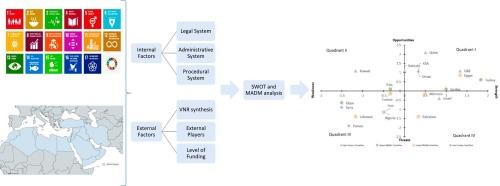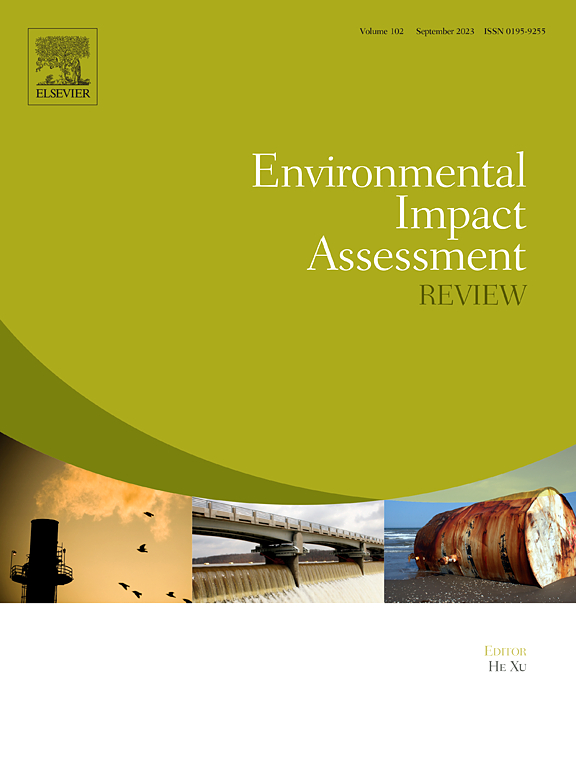可持续发展目标实施情况的比较分析:测试新型评估框架方法
IF 9.8
1区 社会学
Q1 ENVIRONMENTAL STUDIES
引用次数: 0
摘要
本研究首次尝试对可持续发展目标的实施状况和系统结构进行比较分析。为此,通过将 SWOT 分析与多属性决策(MADM)过程相结合,测试了一种新颖的分析框架方法,该过程涉及基于选定的定量和定性标准的绩效评估,以及国家自愿性国家审查(VNRs)中反映的各国对可持续发展目标实现情况的自我评估。绩效评估基于内部因素(行政、法律和程序结构)和外部因素(自愿性国家审查、外部参与者和资金水平)。然后,根据各国在这些因素方面的得分,将其置于象限系统中,从而揭示其在实施可持续发展目标方面的优势、劣势、机遇和威胁。以中东和北非地区(MENA)为试验平台,对该框架进行了区域性测试,涉及 20 个相邻国家。研究结果表明,经过测试的框架方法非常有效,揭示了该地区可持续发展目标实施水平的差异性,其特点是优缺点各不相同,面临的挑战与若干内部和外部因素有关。最值得注意的是,认为高收入是成功实施可持续发展目标的决定因素的看法并不一定准确,这一点在经过测试的框架方法中也得到了证明。高收入国家可能拥有实力和机遇,但也可能因内部治理或外部地缘政治挑战等其他影响因素而面临挫折。相反,低收入国家并不一定处于弱势和受威胁的地位,一些高收入和中等收入国家也面临着类似的挑战。在结束语中,我们强调了可在国家层面改善可持续发展目标实施系统发展的措施。本文章由计算机程序翻译,如有差异,请以英文原文为准。

Comparative analysis of SDGs implementation: Testing a novel assessment framework approach
This study presents a first attempt of a comparative analysis of the sustainable SDGs implementation status and systems' structure. For this purpose, a novel analytical framework approach was tested by coupling a SWOT analysis with a multi-attribute decision making (MADM) process involving a performance assessment based on selected quantitative and qualitative criteria and countries' self-assessment of SDGs achievement reflected in Voluntary National Reviews (VNRs). This performance assessment was conducted based on internal (administrative, legal, and procedural structures) and external factors (Voluntary National Reviews, external players, and funding levels). Countries are then positioned in a quadrant system based on their scores in these factors, revealing their strengths, weaknesses, opportunities, and threats in SDGs implementation. The framework was tested at a regional level with the Middle East and North Africa (MENA) region as a test bed involving twenty adjacent countries. The findings showed the effectiveness of the tested framework approach revealing the heterogeneity of the SDGs implementation level in the region, characterized by varying strengths and weaknesses with challenges related to several internal and external factors. Most notably, the perception that high income is the determinant of successful SDGs implementation is not necessarily accurate as demonstrated otherwise in the tested framework approach. High-income countries may achieve a position of strength and opportunity but can face setbacks due to other influencing factors such as internal governance or external geopolitical challenges. Conversely, low-income countries are not necessarily condemned to a position of weakness and threats with some high and middle-income countries also facing similar challenges. In closure, we highlight measures that can improve the development of the SDGs implementation system at the country level.
求助全文
通过发布文献求助,成功后即可免费获取论文全文。
去求助
来源期刊

Environmental Impact Assessment Review
ENVIRONMENTAL STUDIES-
CiteScore
12.60
自引率
10.10%
发文量
200
审稿时长
33 days
期刊介绍:
Environmental Impact Assessment Review is an interdisciplinary journal that serves a global audience of practitioners, policymakers, and academics involved in assessing the environmental impact of policies, projects, processes, and products. The journal focuses on innovative theory and practice in environmental impact assessment (EIA). Papers are expected to present innovative ideas, be topical, and coherent. The journal emphasizes concepts, methods, techniques, approaches, and systems related to EIA theory and practice.
 求助内容:
求助内容: 应助结果提醒方式:
应助结果提醒方式:


